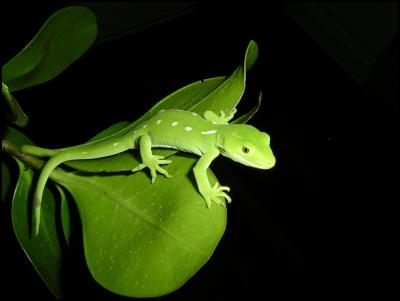On the lookout for lizards
On the lookout for lizards

Click to enlarge
Wellington green gecko, DOC
Date: 10 November
2008
On the lookout for lizards
Conservation staff on the DOC Poneke area-managed Matiu/Somes Island in Wellington Harbour are preparing for an exciting arrival on Friday’s 10 am ferry sailing.
15 rare Wellington green geckos, seven of which have spent the last twelve months on ‘sabbatical’ at the city’s Karori Sanctuary, are being released on the island on Friday 15 November as part of an annual translocation programme – the largest to date.
DOC first began translocating green geckos to the island sanctuary in 2006 to create a self-sustaining population on this predator-free island. They have been working with local lizard breeders to ensure a genetically diverse supply of geckos for release on a yearly basis. This year, 16 lucky local school children with a special interest in conservation have been chosen to take part in the release.
‘Establishing a safe population on Matiu/Somes will help ensure survival’, said DOC biodiversity ranger Brent Tandy.
Local lizard enthusiasts and conservation projects like Karori Sanctuary play a critical support role for DOC’s gecko recovery programme in terms of both advocacy and breeding. One year old animals are taken to the Sanctuary for display in a special gecko enclosure before being released on the island at two years old.
‘Having these animals on display at the Sanctuary has helped us discover a population of geckos we didn’t even know we had’ said Sanctuary education officer Tom Lynch
‘Despite their distinctive colour, green geckos are surprisingly hard to spot. By enabling visitors to see these animals close up, and to learn about their behaviour, we hoped our visitors could help us find out if we had a wild population. Shortly after we established the enclosure, we got the first confirmed sighting of a green gecko in the Sanctuary Valley for 30 years!’
The Wellington green gecko is unique to the lower North Island and is in gradual decline due to habitat loss and predation by introduced species. Vulnerable from a range of predators including cats, hedgehogs, rats and mice, all lizards are fully protected, which means they can be handled but not kept in captivity without permission. Mapping out populations in the region gives DOC better understanding of where they are found and how healthy these populations are.
Do you have geckos in your
garden?
The Department of Conservation would like to
hear about sightings of Wellington green geckos. These
animals are bright green, often marked by two rows of yellow
cream to white blotches, and the inside of their mouth is
blue. Usually found in forested areas these
well-camouflaged omnivores have been found in suburbs across
Wellington City and the Hutt Valley.
There are measures
people can take to offer protection for lizards in their own
gardens, including planting and creating artificial cover
like rock piles or old tiles.
‘Divaricating or complex shrubs like the shrubby tororaro, matagouri or speargrasss can help protect lizards form predators’, said DOC’s Brent Tandy.
‘Clump-forming plants such as cabbage tree, flax or swamp sedge are also good and ground covers like ferns, tussocks and rengarenga lilies can help provide retreat.’
Sightings of green geckos should be reported to DOC’s Poneke Area Office on 04 472 5821.
ENDS


 NZ Association of Scientists: Science System Advisory Group Report Receives Only Selective Engagement From Government
NZ Association of Scientists: Science System Advisory Group Report Receives Only Selective Engagement From Government New Zealand Defence Force: NZDF Celebrates Successful Launch Of A Second Satellite Payload
New Zealand Defence Force: NZDF Celebrates Successful Launch Of A Second Satellite Payload Universities New Zealand - Te Pokai Tara: Universities NZ Welcomes Findings In Science System Advisory Group Report
Universities New Zealand - Te Pokai Tara: Universities NZ Welcomes Findings In Science System Advisory Group Report AMI Insurance: AMI Reveals NZ’s Top Stolen Cars For 2024
AMI Insurance: AMI Reveals NZ’s Top Stolen Cars For 2024 Callaghan Innovation: Callaghan Innovation To Support Staff And Customers Through Disestablishment
Callaghan Innovation: Callaghan Innovation To Support Staff And Customers Through Disestablishment Parrot Analytics: Netflix Earnings - Low Churn And Supply Share Growth Helps Netflix Lead The Way
Parrot Analytics: Netflix Earnings - Low Churn And Supply Share Growth Helps Netflix Lead The Way



